TIMODAZ: A successful international cooperation project to investigate the thermal impact on the EDZ around a radioactive waste disposal in clay host rocks
Xiangling Li
ESV EURIDICE GIE (The European Underground Research Infrastructure for Disposal of Nuclear Waste in Clay Environment), Mol, Belgium
TIMODAZ: A successful international cooperation project to investigate the thermal impact on the EDZ around a radioactive waste disposal in clay host rocks
Xiangling Li∗
ESV EURIDICE GIE (The European Underground Research Infrastructure for Disposal of Nuclear Waste in Clay Environment), Mol, Belgium
ARTICLE INFO
Article history:
Received 26 March 2013
Received in revised form 1 May 2013
Accepted 10 May 2013
Nuclear waste disposal
Damaged zone (DZ)
Thermo-hydro-mechano-chemical (THMC) perturbation
Clay formations
TIMODAZ project
Performance assessment (PA)
Safety case
Multi-scale
Disposal of spent nuclear fuel and long lived radioactive waste in deep clay geological formations is one of the promising options worldwide. In this concept of the geological disposal system, the host clay formation is considered as a principal barrier on which the fulfillment of key safety functions rests. Between 2006 and 2010, the European Commission project TIMODAZ, which gathered 15 partners from 8 countries, has investigated the coupled thermo-hydro-mechanical (THM) effects on clay formations for geological disposal of radioactive waste, and specific attention was paid to investigating the thermal effect on the evolution of the damaged zone (DZ). Three types of potential host clay formations were investigated: the Boom Clay (Belgium), the Opalinus Clay (Switzerland) and the Callovo-Oxfordian argillite (France). Intensive experimental (laboratory and in situ in underground research laboratories) and numerical studies have been performed. Multi-scale approach was used in the course of the project. High degree of similarities between the failure modes, sealing process, stress paths, deformation, etc., observed in laboratories and in situ has been obtained, which increased the confidence in the applicability of laboratory test results and up-scaling perspective. The results of the laboratory and in situ tests obtained allowed the parameters for numerical models at various scales to be derived and provided the basis for the simplified performance assessment models that are used to assess the long-term safety of a repository. The good cooperation between the numerical modeler and experimenters has allowed an in-depth analysis of the experimental results and thus better understanding the underlying processes, and consequently increased the capabilities to model the THM effects in claystones. This paper presents the main achievements obtained by TIMODAZ project and shows how a European scientific community investigates a problem of concern in a collaborative way and how the obtained main results are applied to the performance assessment of a geological repository.
© 2013 Institute of Rock and Soil Mechanics, Chinese Academy of Sciences. Production and hosting by Elsevier B.V. All rights reserved.
1. Introduction
In all nuclear power generating countries, the management of spent nuclear fuel and long lived radioactive waste is an important environmental issue today. Disposal of these wastes in deep clay geological formations is one of the promising options worldwide. In this concept, the host clay formation is considered as a principal barrier on which the fulfillment of key safety functions rests. Hence, preventing unnecessary damage to the host formation is one of the objectives of repository design. A proper evaluation of the damaged zone (DZ) in the host formation is thus an important issue for the long-term safety of geological disposal.
In any case, the excavation process of geological repository cavities (disposal drifts, transport galleries and access shafts) and its later operation inevitably lead to the creation of a DZ within clay around the engineered part of the disposal system.
As a side effect of radioactive decay, vitrified high-level wastes and spent fuel release significant amount of heat, even after several decades of cooling in surface facilities. The influence of the thermal load on the performance of the disposal system is particularly important, since the early transient thermo-hydromechanical (THM) perturbation might be the most severe impact that the repository system will undergo on a large spatial scale and in a relatively short period of time.
Between 2006 and 2010, within the 6th EURATOM Framework Programme of European Community (EC FP6), the TIMODAZ project (thermal impact on the DZ around a radioactive waste disposal in clay host rocks) (http://www.timodaz.eu/) has investigated the coupled THM effects on clay formations that are being studied as potential host rocks for geological disposal of radioactive waste. The project focused on the combined effect of the excavation damaged zone (EDZ) and the thermal output on the host rock. The influences of the temperature increase on the evolution of the EDZ as well as the possible additional damage created by the thermal load were also the main issues of the study. The chemical evolution and its interaction with the THM processes around the underground repository were also addressed in the project, but in a limited extent.The research activities covered by TIMODAZ call for multidisciplinary expertise involving both European radioactive waste management organisations together with the main nuclear research institutes supported by other research institutions, universities, industrial partners and consultancy companies. The TIMODAZ consortium is composed of 15 participating organisations representing 8 countries in total: EURIDICE (Belgium), NAGRA (Switzerland), SCK·CEN (Belgium), GRS (Germany), NRG (Holland), CIMNE (Spain), EPfl(Switzerland), ULG (Belgium), UJF (France), ENPC (France), CEG-CTU (Czech), ITASCA (France), ASC (UK), ITC (Switzerland) and SOLEXPERTS (Switzerland). Moreover, to ensure an appropriate and continuous link between the end-user needs and the priorities of the TIMODAZ project, the following end-user group has been constituted: ONDRAF/NIRAS (Belgium), NAGRA (Switzerland), ANDRA (France), RAWRA (Czech). This group was active throughout the duration of the project.
Three types of clays that are currently studied as potential host rocks due to their favorable properties were investigated: the Boom Clay (BC) from Belgium, the Opalinus Clay (OPA) from Switzerland and the Callovo-Oxfordian argillite (COx) from France. Even if the characteristics of these clays are different, the THM processes governing the fracturing and the sealing present some similarities. Within the EC FP5 project SELFRAC (fractures and self-healing within the EDZ in clays), both laboratory and in situ tests performed in the corresponding underground research laboratory (URL) demonstrated the self-sealing capacity of both BC and OPA, the former presents a faster self-sealing process than the latter (SELFRAC, 2007). In the TIMODAZ project, new laboratory experimental equipments, non-conventional in soil mechanics, and test protocols were developed to study, on different scales, the DZ creation process and its evolution (including sealing/healing capacity) under thermal loading and potential additional heating induced damage. Advanced technology, like X-ray micro-tomography (X-ray μCT) was systematically applied in the laboratory tests to observe the development and evolution of cracks and discontinuities in the testing samples. Specific efforts were devoted to investigating the evolution of the permeability, the most relevant parameter for the performance assessment (PA), under different THM loading paths. New in situ tests on small and large scales were also carried out to contribute to a better understanding of the processes occurring within the clay around a disposal system for heat-emitting waste during the thermal transient phase. All experimental researches were closely linked with the development and testing of sound phenomenology-based models which are essential in meeting the safety requirement of adequate understanding of the long-term evolution. The step-by-step approach to model the tests has provided a better understanding of the underlying processes and increased the prediction capacity of the developed models. Furthermore, specific attentions were paid to the integration of all experimental and modelling developments within the long-term PA contexts and assessment of the significance of DZ and its evolution in safety case.
The strong interaction between experimenters has lead to a multi-scale approach development in the course of TIMODAZ project. The high degree of similarities between the failure modes, sealing process, stress paths, deformation, etc., observed in laboratories and in situ resulted in a better understanding of the process and increased the confidence in the applicability of laboratory test results and up-scaling perspective.

Fig. 1. The multiple perturbations of the host rock over the lifetime of a repository in clay formation (from Sillen, 2012).

Fig. 2. Fracture patterns in Boom Clay observed at Mol site: around a gallery (top), around a resin-immobilized borehole (bottom-left) and along a retrieved core (bottom-right) (Bernier et al., 2007).
This paper presents the main achievements obtained by TIMODAZ project and shows how a European scientific community investigates a problem of concern in a collaborative way and how the obtained main results are applied to the PA of a geological repository.
2. Perturbation over the lifetime of repository
Building a repository will unavoidably induce the multiperturbation of the host rock. The key process and outstanding issues evolve over the lifetime in the development of a repository (Fig. 1, where σ, ε, u, s, and θ refer to the stress, the strain, the pore water pressure, the matrix suction and the water content, respectively, symbol Δ stands for variation). The evaluation of the influence of the DZ on repository safety requires investigation of different stages in the lifetime of a repository.
3. DZ in early stage of a repository
The excavation of underground openings will lead to stress redistributions and may induce rock failure around the cavities. The size and characteristics of such an excavation disturbed or damaged zone (dZ/DZ) and the impact on hydraulic properties is controlled by the local (secondary) stress state, the pore pressure development and the physical properties of the host rock including the heterogeneity and the potential anisotropy, the presence of the pre-existing discontinuities (including bedding) and the geometry of the opening itself and the excavation/support techniques used.
Figs. 2–4 show DZ patterns observed in BC in the HADES URL at Mol in Belgium, in COx in the Meuse/Haute-Marne URL at Bure site in France, and in OPA at Mont Terri URL in Switzerland, respectively.
4. Self-sealing of clays
The permeability in the DZ is enhanced by a porosity increase or the creation of tensile or shear fractures. An initial increase in permeability of five orders of magnitude has been measured at Mont Terri (Tsang et al., 2012).
A similar magnitude increase was measured at Bure URL (Armand et al., 2007), whereas at Mol a two-orders-of-magnitude increase was observed at the time where the first measurements were made (Bernier et al., 2007). However, this enhanced permeability tends to decrease over time and back to its initial value because of clay swelling and clay creep behaviour, especially in cases where swelling refill materials are used to provide a back pressure on the rock. The clay formations present a self-sealing capacity.
5. Multi-scale experimental program in TIMODAZ
The behaviour of the DZ, initiated during the repository construction, evolves with the changing conditions that vary from the open-drift period to the initial closure period and the entire heating-cooling cycle of the decaying waste.
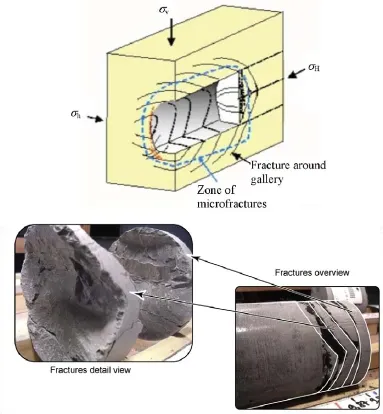
Fig. 3. Fracture patterns in COx observed at Bure site: herringbone patterns around the gallery parallel to major horizontal stress σH(top) and at a retrieved core (bottom) (Wileveau and Bernier, 2008).
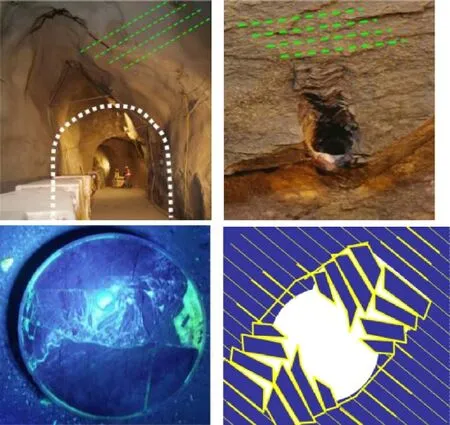
Fig. 4. Fracture patterns in OPA observed at Mont Terri site: around the gallery (top-left) and borehole (top-right) (the green lines denotes the orientation of bedding), a section along a overcored borehole (UV-light) (bottom-left) and conceptual model of borehole damage zone (bottom-right) (Vietor et al., 2010).
The DZ and its evolution with time has been characterised and its impact on the performance of radioactive waste geological repositories has been assessed within the EC FP5 project SELFRAC (SELFRAC, 2007).
Within the TIMODAZ project, beyond further characterisation of the initial damage induced by the excavations, the extent and the hydro-mechanical (HM) behaviour of the DZ during different repository evolution stages (including the operational period and thermal and post-thermal post-closure stages) were investigated thanks to a multi-scale experimental program in laboratory and in situ.
The general objective of the tests in laboratory is to perform the tests under well controlled temperature/stresses/hydraulic conditions with different well-defined loading paths in order to determine the parameters of the THM constitutive models used for the numerical modelling and, more specifically, to investigate the thermal effects on the damaged clay and the possible damage induced by the thermal loading itself, while the in situ tests aim at further investigating the underlying process and providing in situ data to validate the laboratory test results in an up-scaling perspective and the developed numerical models as well.
5.1. Advanced equipment in laboratories
The problem addressed in the project is a complex THM problem typical of the near field of a repository, also accounting for the effects of discontinuities, sealing and partial saturation on fluid transfers. The experimental challenges faced to tackle such complex coupled THM phenomena associated with damage evolution in the DZ are significant. As a consequence, a great variety of experimental techniques not so commonly used in geomechanics have been developed and used. During the tests, different techniques were used to evaluate the damage and sealing/healing processes: μCT, water/gas permeability measurements, etc. (Delage, 2010; Labiouse, 2010).
Specifically, the very low permeability of the clays investigated also involves quite long testing periods and thus asks specific experimental precautions (both in the shearing and heating phases). Fig. 5 shows the hollow cylinder cell developed at ENPC, France, so as to provide a short drainage length of 10 mm (the half thickness of the hollow cylinder), compared to 38 mm in the case of standard triaxial samples drained on top and bottom. Roughly, the corresponding rate in terms of water transfers (initial saturation, drained nature of the tests) is estimated to be 16 times faster than in the case of a standard 76 mm high triaxial sample, given the diffusion nature of water transfer equation (Monfared et al., 2011, 2012).
Fig. 6 illustrates the sorption bench developed in EPFL, to study the effect of the variation of relative humidity (RH) on the soil behaviour at different temperatures, mainly for the water retention curve determination. Indeed, concern about the RH changing may be a significant issue over a long time period for a repository: tunnel ventilation during the open drift stage, potential desaturation during heating, and finally gas production from corrosion and degradation of repository engineering materials during the post-closure stage, etc.
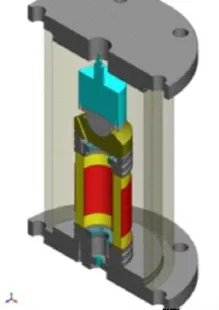
Fig. 5. New ENPC hollow cylinder triaxial cell.

Fig. 6. Experimental layout of EPflsorption bench.
To investigate speci fically whether the temperature affects the self-sealing capacity of clays, speci fic permeameter was designed and constructed by SCK·CEN. As schematized in Fig. 7, three filters were placed on the top of sample to enable the measurement of water flow through the fracture (arti ficially pre-made) and the intact matrix separately through the central filter and the two side filters. The cells were mainly made up of organic polymer polymethylmethacrylate (PMMA) allowing CT scans on the samples due to its low attenuation to X-rays (Delage, 2010; Chen et al., 2013).
Significant efforts were devoted to performing the tests in laboratory by simulating as close as possible the conditions in a real repository on different scales.
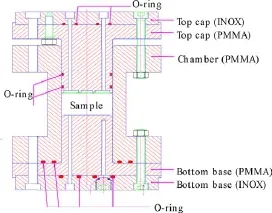
Fig. 7. SCK·CEN permeameter test setup with 3 top filters.
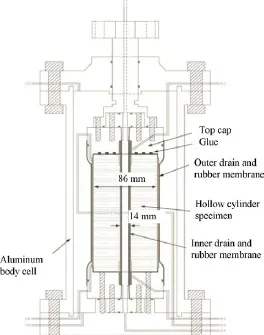
Fig. 8. EPflmiddle-scale hollow cylinder triaxial cell.
Fig. 8 illustrates the middle-scale hollow cylinder triaxial cell developed in EPflto perform the simulation tests with the mechanical and thermal loadings fairly similar to the evolution that will be encountered around disposal galleries for heat emitting radioactive waste. In order to allow the X-ray tomography of the sample inside the cell at different steps of the experiment, the usual steel body cell was replaced by the aluminum body cell. Four GDS pressure controllers were equipped to achieve an independent control of external confining pressure, internal hole pressure, external pore pressure, internal pore pressure. The developed device is thus able to (a) create an EDZ around the central hole of the cylinder, (b) apply a thermal load in the central hole, (c) carry out permeability (radial) measurements at different steps of the experiment, and (d) carry out tomography measurements at different steps of the experiment.
Fig. 9 shows a similar, but on a larger scale, hollow cylinder triaxial cell developed in GRS which also allows monitoring the axial air/water permeability variation. In Fig. 9, D and d refer to the external and internal diameters of hollow cylinder of tested sample, respectively.
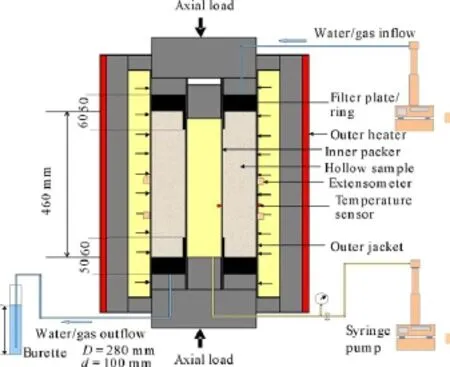
Fig. 9. GRS large scale hollow-cylinder triaxial cell.
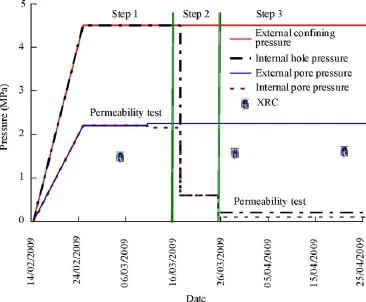
Fig. 10. Testing procedure adopted for simulation tests (step 1: recovery ofin situ stress conditions; step 2: EDZ creation; step 3: heating/cooling cycle).
5.2. Selected key results obtained in laboratory and in situ
5.2.1. Similarity on failure mode between laboratory and in situ
In EPFL, middle scale simulation tests were performed on both BC and OPA with the help of middle scale hollow cylinder triaxial cell (Fig. 8). The test procedure is illustrated in Fig. 10. Permeability measurements and X-ray computerized tomography (XRCT) were carried out in different steps of the experiments. These results were then checked after disassembly of the test by visual inspection of saw-cut sections. Moreover, for tests on BC, two different image processing methods were applied to quantify the displacement: the digital image correlation (DIC) to map the displacement field and the particle manual tracking (PMT) which consists in tracking the movement of pyrite inclusions in natural BC identified in the images before and after the mechanical unloading.
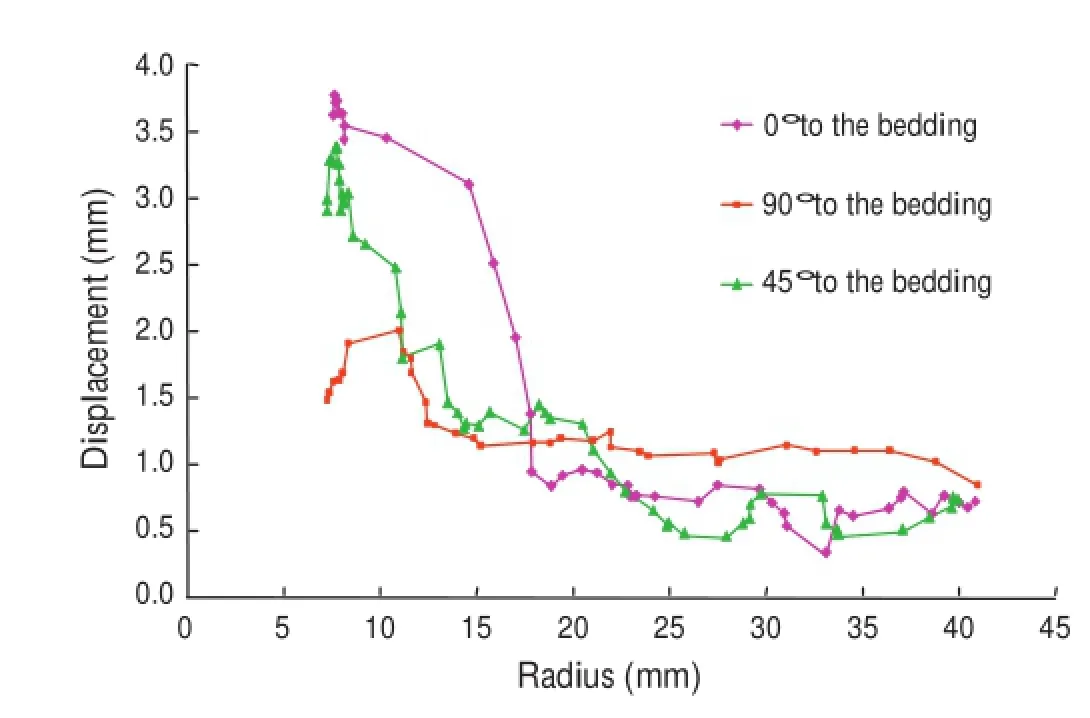
Fig. 11. Example of results obtained from the tracking of pyrite inclusions in the X-ray scans. Radial convergence determined along three directions: parallel to bedding (magenta curve), perpendicular to bedding (red curve) and at 45°(green curve). Original diameter ofinner hole: 14 mm.
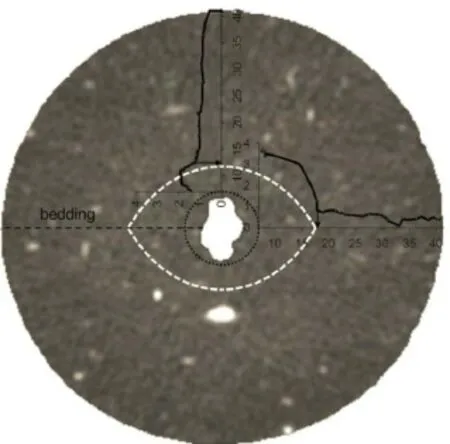
Fig. 12. Eye-shaped damaged zone in Boom Clay around the central hole as inferred from the slope discontinuity observed in the displacement profiles.
Fig. 11 shows an example of results obtained from the tracking of pyrite inclusions after mechanical unloading (simulating excavation) on a BC sample cored parallel to bedding plane. One observes that the convergence near the hole is higher in the direction parallel to the bedding planes than that in the perpendicular one, and a reverse trend is observed further inside the sample, which can be considered as the “elastic” zone. This anisotropic displacement field was obtained and con firmed by DIC imaging process. Based on the displacement pro files, a “damaged” zone can be delimited visually around the central hole. It could actually have an eyeshape (Fig. 12), as suggested by observations at Mol URL in BC (see Fig. 2). The anisotropic convergence around the central hole is consistent with the in situ observation in BC. During the excavation of the connecting gallery and Praclay gallery in Mol, the convergence appeared to be higher in the horizontal direction (so parallel to bedding) than in the vertical direction (so perpendicular to bedding) (for Praclay gallery, 81 mm versus to 55 mm) (Van Marcke and Bastiaens, 2010). The difference in convergences in the “elastic” zone in the directions parallel and perpendicular to bedding can partly be explained by the anisotropy of elastic properties of BC, as the observed ratio of about 2 is in agreement with the ratio between Young’s modulus in the directions parallel and perpendicular to bedding back analyzed from the ATLAS experiment at Mol (see Section 6.1 below). However, it can also be related to the development of the anisotropic “damaged” zone around the central hole and to the consequent redistribution of stresses (Labiouse et al., 2013).
Fig. 13 gives an example of test results on one OPA sample cored parallel to the bedding. After the removal of the sample from the testing cell, high-resolution XRCT of the central part of the sample was performed.
The cross sections show cracks mainly along the bedding planes (indicated by the white lines). The bedding plane failure is followed by buckling, rotation and slab-like breakouts in two regions that extend from the borehole normal to the bedding. The slab thickness is regular but increases systematically away from the borehole. The width of the deformed region is similar to the diameter of the borehole. In axial direction, the fractures constitute a connected network (Fig. 13, lower left). After impregnation of the sample with resin and saw cutting normal to the hole axis, the bedding controlled EDZ was clearly visible (lower-right picture of Fig. 13a) (Labiouse and Vietor, 2013).
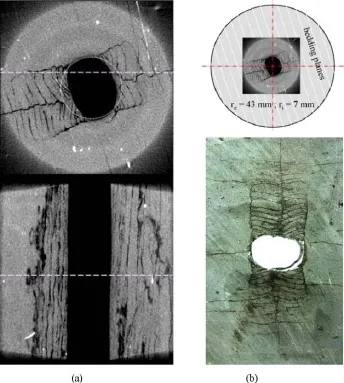
Fig. 13. Fractures pattern observed after the laboratory test (a) by means of a highresolution XRCT (left and upper-right pictures) and (b) visualization after sawing of the sample (lower-right). Original diameter of the inner borehole: 14 mm.
In situ investigation has been performed in the Mont Terri URL around a borehole that follows the bedding strike of the OPA in TIMODAZ project. After injecting a fluorescent resin and over-coring afterwards the injected borehole, sections of the core were sawcut to study the damage around the borehole. As seen in Fig. 4 (bottom-left), the resin trace image presents a buckling fracture mode controlled by the bedding orientation. Inspection of the entire set of slices showed that the geometry and extent of the elliptical opening result from a larger convergence in the direction normal to bedding than parallel to bedding. A sketch of the borehole collapse pattern is given in Fig. 4 (bottom-right). This collapse structure demonstrates that the deformation and failure of the clay are controlled by the bedding. Also, the DZ shape appears to be controlled by the orientation of the opening with respect to the bedding. The geometry and extent of the fracture pattern have shown thus a striking similarity with the DZ observed around the central hole of the hollow cylinder tests.
By comparing the geometry and extent of the DZ obtained by laboratory simulation tests and in situ, it revealed that the deformation around an opening and the DZ is developed in reverse directions in BC and OPA. It has an eye-shape in BC with a major axis in the bedding planes direction whereas it extends in the direction normal to bedding in OPA and is limited to the width of the hole. The difference in exhibited damage pattern most probably results from different failure modes: ductile behaviour in the BC (i.e. shear failure prevails along conjugated planes) and brittle behaviour in the OPA (tensile failure along bedding planes and buckling) (Labiouse and Vietor, 2013).
The consistency among experiments carried out over various scales provides good confidence about up-scaling laboratory tests to repository-scale tests.
5.2.2. Temperature effects on damage and self-sealing
Various types of laboratory tests were performed in different laboratories with the objective to determine the permeability variation under different THM loading paths.
In SCK·CEN, permeameter tests (samples with constant volume) were carried out on BC and OPA to evaluate the combined effect of temperature and geochemistry of the pore water on the sealing capacity of the clays. The CT imaging was performed on fractured samples before and after the tests (both for BC and OPA) and one month after dismantling and desaturation at ambient air (BC only) to follow the fracture apertures and density changes within the samples (Chen et al., 2013).
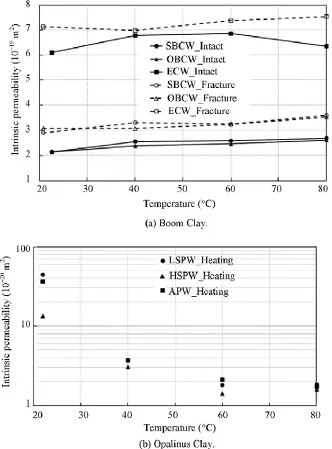
Fig. 14. Variation of the intrinsic permeability with temperature for Boom Clay and for Opalinus Clay. (a) Boom Clay. (b) Opalinus Clay.
For each cell, the bottom of the sample was connected to an injection system with different solutions at a constant injection pressure; the outflows were connected at the top under the atmospheric pressure.
Different chemical conditions are considered: a chemically undisturbed environment, an oxidised environment and an alkaline environment. The following test solutions were chosen as injection fluids for the tests on the BC: synthetic BC water (SBCW), oxidized BC water (OBCW), and an alkaline solution composed of a synthetic BC water solution saturated with calcium hydroxide (representing “evolved cement water”, ECW). The test carried out with SBCW served as reference to investigate the sealing of the chemically undisturbed BC.
The following solutions were chosen as injection fluids through OPA samples: low-saline Pearson water (LSPW), high-saline Pearson water (HSPW), and an alkaline solution composed of a low-saline Pearson water saturated with calcium hydroxide (APW). The high- and low-salinity Pearson water compositions encompassed a typical range of chemical composition of the interstitial fluid presented in the OPA formation at Mont Terri.
The principal results are given in Fig. 14. The test results indicated in general that the BC has a well and faster sealing capacity compared to OPA. A fractured BC sample was put in the permeameter cell for 4–6 days without further hydration, and the fractures could not be visualized by the CT scans. The subsequent permeability tests indicated that the flows from the central filter where fracture was made in the sample do not show much difference from the flows from the side filters. This suggested that the fractures have already been sealed before the test. During a subsequent heating up to 80°C, the intrinsic permeability of both intact samples andsamples with artificial fractures remained constant. This suggests that the pore structure of the clay matrix was not affected by the temperature increase. The temperature influences only the water viscosity (reversible), as already shown in the BC by Delage et al. (2000). Similar tests carried out with cement water showed that pore water chemistry had little influence on the permeability of the BC. The temperature has at least non-negative effect on the self-sealing.

Fig. 15. Sequence of stages of a typical test at UJF.
The permeameter tests on OPA specimens with artificial fractures indicated that, unlike BC, the intrinsic permeability (Fig. 14b) decreased with the increasing temperature, suggesting that the temperature effect has a strong beneficial effect on the hydraulic behaviour of OPA.
The same phenomenon was also observed in the Mont Terri in situ SE-H borehole heater test performed in the TIMODAZ project, in which the intrinsic permeability showed a continuous decrease by a factor of about 4 when the temperature at the measurement point increased from 15.1°C to 65.3°C. It has to be taken into consideration that the interpreted permeability reduction was calculated from hydraulic tests. It must be noted that the methods applied for the interpretation of these tests have been developed for constant temperatures over time and over distance, and, amongst others, the influences of rock mechanical coupled effects are assumed to be negligible. Therefore, the results of the hydraulic tests have always to be considered as approximation (Vietor et al., 2010).
At UJF, triaxial HTM tests were performed to study the effect of a thermal loading (heating/cooling process) on the mechanically damaged clay, i.e. to evaluate the impact of the thermal loading on the process of localisation and/or fracturing.
A complete HTM test includes several stages as illustrated in Fig. 15. XRCT was applied before and after the test to visualize the fracture pattern (Bésuelle et al., 2013).
For the deviatoric loading, different paths have been followed in the experiments either under “drained” or “undrained” conditions. The test adopting a unconventional mixed-mode control paths (by applying a constant axial strain rate and decreasing in the meantime the cell pressure) to mimic a stress path similar to the one resulting from tunnel excavation where the deviatoric stress increases while the total mean stress decreases.
Permeability is measured at four stages of a test (Fig. 15). The main result from these measurements was that essentially no significant changes of permeability were associated neither with the mechanical shearing nor with the thermal loading for both BC and OPA.
At ENPC, hollow cylinder triaxial THM tests were performed on both BC and OPA under different stress paths and different hydraulic boundary conditions (Fig. 16). All tested samples were saturated under approximately in situ stress conditions to limit the swelling and better preserve the initial state of the sample. Permeability was measured at different stages of the test by using the transient method based on the pore pressure dissipation curves measured by pressure transducers installed at different positions, allowing measurement of the anisotropic permeability.
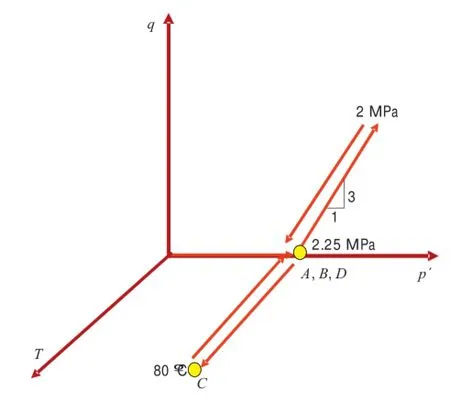
Fig. 16. Thermo-hydro-mechanical stress path for Boom Clay (test 2).
The permeability evolution during the test 2 on BC is given in Table 1, where krand kzrefer to the permeability measured in radial and vertical directions, respectively, and shows (Delage, 2010):
(1) A decrease in permeability after shearing (drained) that can be explained by the increase in total mean stress during the shearing phase. There is no apparent effect of the shear plane on pore pressure diffusion and permeability, confirming the good self-sealing properties of BC.
(2) The faster dissipation of the pore pressure at 80°C can be explained by the decrease of water viscosity, with no significant effect on the intrinsic permeability.
(3) Permeability goes back to initial value (point C) after cooling, confirming again the very good sealing properties of BC. The thermal effect on the permeability is reversible.
However, it has to be noted that XRCT before and after testing performed at UJfindeed showed that pre-existing discontinuities on so-called “intact” samples appeared to be quite significant for both BC and OPA. This is of course a concern when attempting to determine constitutive parameters describing the shear behaviour, since the samples to test does not appear to be continuous because of pre-existing damage due to the sensitivity of the clays to excavation, drying, storage, transport and wetting. Nevertheless, the permeability tests carried out independently in various laboratories by using different approaches on either artificial pre-existing or shear discontinuities all provided permeability values that were close to the matrix permeability. This also holds for different pore water chemistry. This is a clear demonstration that fissures, that are known to exist thanks to μCT investigation carried out before and after the tests, are not detected when running permeability tests. It is hence a confirmation of the excellent self-sealing behaviourof the three clays/claystones presently considered as possible geological barriers in Europe. This is perhaps one of the major achievements of the TIMODAZ project (Delage, 2010; Li, 2010).

Table 1Permeability values obtained along the thermo-hydro-mechanical-damage stress path of test 2 on Boom Clay.
6. Step-by-step modelling development program
In the course of the whole TIMODAZ project, the strong interaction among the experimenters and modellers lead to a step-by-step development of the modelling both on the constitutive laws and the numerical tool. Step-by-step numerical modelling of laboratory and in situ tests has allowed a better understanding of the underlying processes and determination of some fundamental THM parameters of studied clays. In this paper, only two examples are given.
6.1. Modelling ofin situ heater test ATLAS III

Fig. 17. Layout of small-scale in situ heater test ATLAS III.

Fig. 18. Measurements of pore water pressure and temperature in the borehole AT93E.
An important thermally-induced effect in low permeability media, such as clays and claystones, is the pore water pressurization that occurs upon heating (Delage, 2010; Mohajeraniet al., 2012). Such strong THM couplings were clearly demonstrated from both in situ and laboratory tests performed in the TIMODAZ project. Magnitude and evolution of both temperature and pore water pressure depend not only on the THM characteristics of media itself (thermal and hydraulic diffusivity, rigidity, etc.), but also on the temperature variation rate.
Two in situ small-scale heater tests were conducted in TIMODAZ, i.e. SE-H borehole heater test at the Mont Terri URL and ATLAS III at the HADES URL at Mol (Vietor et al., 2010). The layout of ATLAS III test is shown in Fig. 17.
Typical temperature and pore pressure evolution are given in Fig. 18, which shows the measurements obtained by a sensor in the borehole AT93E. One can observe that the pore pressure presents a“bump” once the heater power changes: after each power increasing, it decreases temporarily before increasing. Once the power is switched off, temperature slightly keeps on increasing prior to decreasing while a peak in pore pressure is observed prior to the dissipation phase.
The numerical modelling of ATLAS III has been carried out in successive steps: from 1D, 2D to 3D by increasing the complexity of THM characteristics step-by-step: from isotropy to anisotropy, effect of thermal plasticity, etc., to better understand their influence on the excess pore water pressure and temperature evolution (Charlier, 2010).

Fig. 19. Thermo-hydro-mechanical anisotropy sensibility analysis on pore pressure (Pw) evolution in ATLAS III test.

Fig. 20. Comparison of numerical and experimental results (day 0 is 2 April 2007).
Fig. 19 illustrates the modelling results by separately considering the anisotropy of each field (THM and their coupling). A zoom of these numerical results indicates that the pore pressure“bumps” can be reproduced only when considering the mechanical anisotropy.
Once we understood the controlling mechanism behind this“apparent” abnormal pore pressure evolution upon heating and cooling (mechanical anisotropic elasticity), by matching the numerical modelling to in situ measurement (back-analysis), a set of THM parameters of BC were obtained which allow producing the in situ measurement as shown in Fig. 20.
Finally, it has been noticed that plasticity does not play an important role in this experiment. The conclusion is that this in situ test characterizes mostly the THM behaviour of the far field host rock. That is why most of the modelling uses thermo-elastic constitutive models.
6.2. Modelling of laboratory simulation test on BC performed by EPFL
The simulation test results on BC performed by EPflindicated clearly the directional dependent responses as mentioned in Section 5.2.1 and in Figs. 11 and 12. The modelling of this laboratory test has been also in a progressive way enabling step-by-step evidencing the important factors which control the deformation and damage mechanism (Charlier, 2010; Franc¸ ois et al., 2013).
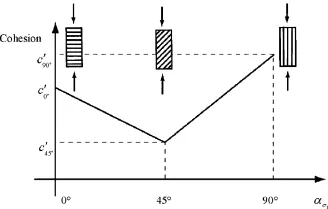
Fig. 21. Schematic view of the cohesion evolution as a function of the angle between the normal vector to bedding plane and the direction of major principal stress.

Fig. 22. Step by step modelling development of hollow cylinder test. (a) Isotropic behaviour. (b) Transversal isotropic elasticity. (c) Transversal elasto-plasticity. (d) Strain localization (total deviatoric strains) by considering the Drucker–Prager with softening.
Firstly, an isotropic material behaviour in modelling was considered, then an elastic transversal-isotropic behaviour and strain softening were added, afterwards, the anisotropic plasticity by considering the directional variation of cohesion with respectto bedding was introduced which results in different plastic yielding of material in different directions related to the bedding (Fig. 21). Finally, the strain localization has been obtained through numerical regularisation technique by applying the HM second gradient model.
Fig. 22 shows the numerical results obtained step-by-step, and the mechanism controlling the deformation and damage has been highlighted. The obtained numerical results evidence the directional dependency of the mechanical response of the clay. The softening behaviour induces transient strain localization processes, evidencing the eye-shaped DZ. The shape of the obtained DZ is clearly affected by the anisotropy of the materials. The irregular shape of the central hole after unloading (see Figs. 11 and 12) is mostly related to the strain localization (Fig. 22d). The modelling results agree with the experiments not only qualitatively (in terms of the shape of the induced DZ) but also quantitatively (for the obtained displacement in three particular radial directions) (Charlier, 2010; Franc¸ ois et al., 2013).
7. Integration of the main results in performance assessment
A proper evaluation of the perturbations of the host rock induced by the excavation and the emplacement of exothermic wastes is essential for the assessment of the long-term safety of high-level radioactive waste disposals in clay formations. In the course of whole project, all experimental and modelling developments were always placed in the long-term PA contexts in concert with the PA experts. At the end of the project, the main results obtained within the TIMODAZ project have been integrated from a PA point of view to verify and justify the validation of the key PA assumptions and the values of PA model parameters.
The results obtained in the TIMODAZ project strengthen the assessment basis of the safety evaluation of the current repository designs. Through the TIMODAZ experimental observations, there was neither evidence of a temperature-induced additional opening of fractures nor of a significant permeability increase of the DZ. Instead, thermally-induced plasticity, swelling and creep were identified that seem to be beneficial to the sealing of fractures and to the recovery of a very low permeability in the DZ, close to that of an undisturbed clay host rock.
Moreover, the favourable properties of the clay host rock, which guarantee the effectiveness of the safety functions of the repository system, are expected to be maintained after the heating-cooling cycle. Hence, the basic assumptions usually made in PA calculations so far are expected to remain valid, and the performance of the system should not be affected in a negative way by the thermal evolution of the DZ around a radioactive waste repository in clay host rock (Yu et al., 2010, 2013).
8. Conclusions
The TIMODAZ has investigated the THMC processes occurring around a repository. It focused on the study of the combined effect of the EDZ and the thermal impact on the repository host rock.
Within the TIMODAZ project, laboratory and in situ experiments on different scales have been conducted to study the temperature effect on the DZ evolution. A great variety of experimental techniques not so commonly used in geomechanics were developed and applied within the TIMODAZ to reach the objectives of the project.
Another important area of the TIMODAZ concerns the numerical modelling development for the simulation of the THMC process around a repository on time and repository scales.
The TIMODAZ has made significant contributions to the understanding of the DZ process and provided insights on the temperature effect on the DZ evolution. The similar results obtained by laboratory and in situ experiments increase the confidence for up-scaling and transfer of the knowledge from laboratory experiments, and in situ tests to real repository scale.
The close collaboration between experimenters, modellers and PA team and the close link with the end-users has played an important role in the success of the project, which allows the phenomenology specialists to target the research within the context of assessments of repository performance and safety and the priority of the end-users (Li, 2010).
Acknowledgements
This work was funded by the European Commission through the TIMODAZ project within the 6th framework programme (Contract Number: FI6W-CT-2007-036449).
The author was the general coordinator of the project from 2007 to 2010. The first coordinator F. Bernier is greatly acknowledged for his contribution to the project.
The success of the project was due to the contributions from all participants of the project. They are too numerous to cite all here. The author is mostly grateful to all of them for their contributions to the project. In particular, she would like to thank all members of governing board of the project for their collaboration in the management of the project and all work-package leaders for their scientific leadership in the course of the project and editing of all deliverables. Finally, she would also like to thank all end-users for their interesting and stimulating discussions in establishing the target of the project during the end-user workshops.
Armand G, Wileveau Y, Morel J, Cruchaudet M, Rebours H. Excavated damaged zone (EDZ) in the Meuse Haute-Marne underground research laboratory. In: Proceedings of the 11th Congress of the International Society for Rock Mechanics. London: Taylor & Francis Ltd.; 2007. p. 33–6.
Bernier F, Li XL, Bastiaens W. Twenty-five years’ geotechnical observation and testing in the Tertiary Boom Clay formation. Géotechnique 2007;57(2):229–37.
Bésuelle P, ViggianiG, Desrues J, Cécile C, Charrier P. A laboratory experimental study of the hydro-mechanical behaviour of Boom Clay. Rock Mechanics and Rock Engineering 2013 (in press).
Simulation of lab and in situ test. Charlier R, editor. Deliverable 13, TIMODAZ project; 2010.
Chen GJ, Maes T, Vandervoort F, Xavier S, Van Marcke P, Honty M, Dierick M, Vanderniepen P. Thermal impact on damaged Boom Clay and Opalinus Clay: permeameter and isostatic tests with mCT scanning. Rock Mechanics and Rock Engineering 2013, in press.
Delage P, Sultan N, Cui YJ. On the thermal consolidation of Boom Clay. Canadian Geotechnical Journal 2000;37(2):343–54.
THM characterisation and input for simulation. Delage P, editor. Deliverable 5, TIMODAZ project; 2010.
Franc¸ ois B, Labiouse V, Dizier A, Marinelli F, Charlier R, Collin F. Hollow cylinder tests on Boom Clay: modelling of strain localization in the anisotropic excavated damaged zone. Rock Mechanics and Rock Engineering 2013, in press.
Laboratory simulation tests. Labiouse V, editor. Deliverable 7, TIMODAZ project; 2010.
Labiouse V, Sauthier C, You S. Hollow cylinder simulation experiments of galleries in Boom Clay formation. Rock Mechanics and Rock Engineering 2013, in press.
Labiouse V, Vietor T. Laboratory and in situ simulation tests of the excavation damaged zone around galleries in Opalinus Clay. Rock Mechanics and Rock Engineering 2013, in press.
Thermal impact on the damaged zone around a radioactive waste disposal in clay host rocks. Li XL, editor. Final activity report, TIMODAZ project; 2010.
Monfared M, Delage P, Sulem J, MohajeraniM, Tang AM, De Laure E. A new hollow cylinder triaxal cell to study the behaviour of low permeable materials. International Journal of Rock Mechanics and Mining Sciences 2011;48(4):637–49.
Monfared M, Sulem J, Delage P, MohajeraniM. A laboratory investigation on the thermal properties of the Opalinus claystone. Rock Mechanics and Rock Engineering 2012;44(6):735–47.
MohajeraniM, Delage P, Sulem J, Monfared M, Tang AM, Gatmiri B. A laboratory investigation of thermally induced pore pressures in the Callovo-OxfordianClaystone. International Journal of Rock Mechanics and Mining Sciences 2012;52:112–21.
SELFRAC. Fractures and self-healing within the excavation disturbed zone in clays. Final technical report (project FIKW-CT2001-1001-00182). European Commission EUR 22585; 2007.
Tsang C, Barnichon J, Birkholzer J, Li X, Liu H, Sillen X. Coupled thermo-hydromechanical processes in the near field of a high-level radioactive waste repository in clay formations. International Journal of Rock Mechanics and Mining Sciences 2012;49:31–44.
Vietor T, Li XL, Chen GJ, Verstricht J, Fisch H, Fierz T. Small scale in situ tests: borehole experiments at HADES and Mont Terri rock laboratories. In: Deliverable 8, TIMODAZ project; 2010.
Van Marcke P, Bastiaens W. Excavation induced fractures in a plastic clay formation: observations at the HADES URF. Journal of Structural Geology 2010;32(11):1677–84.
Wileveau Y, Bernier F. Similarities in the hydro-mechanical response of Callovo-Oxfordian Clay and Boom Clay during gallery excavation. Physics and Chemistry of the Earth 2008;33:S343–9.
Sillen X. Keynote on repository-induced perturbations of the host rock, in the context of the safety case for the geological disposal of VHLW and Sfin clay formations. In: Proceedings of the European Commission TIMODAZ-THERESA International Conference. Brussels, Belgium: European Commission; 2012. p. 159–71.
Yu L, Weetjens E, Vietor T, Hart J. Integration of TIMODAZ results within the safety case and recommendations for repository design. In: Deliverable 14, TIMODAZ project; 2010.
Yu L, Weetjens E, Sillen X, Vietor T, Li X, Delage P, Labiouse V, Charlier R. Consequences of the thermal transient on the evolution of the damaged zone around a repository for heat-emitting high-level radioactive waste in a clay formation: a performance assessment perspective. Rock Mechanics and Rock Engineering 2013, in press.
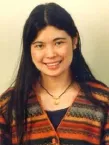
Xiangling Li is a principal research scientist at the Belgian Nuclear Research Center (SCK·CEN) and currently serves as the Scientific Manager of E.I.G. EURIDICE (The European Underground Research Infrastructure for Disposal of Nuclear Waste in Clay Environment), an economical interest grouping between SCK·CEN and ONDRAF/NIRAS (Belgian National Agency for Radioactive Waste and Enriched Fissile Material), and the head of expertise group of EURIDICE in SCK·CEN. She graduated as a Geological Engineer in 1983 from Changchun University of Geology in China (actual Jilin University) and got her Ph.D. degree
in applied science (thermal-hydro-mechanical behaviour of saturated/unsaturated soil) from Liège University in Belgium in 1999, she joined E.I.G. EURIDICE in 2001. E.I.G. EURIDICE carries out the feasibility studies for the disposal of high-level and long-lived radioactive waste in clay layers. In this way EURIDICE contributes to the national disposal programme run by ONDRAF/NIRAS. Since 2000, the URL HADES (High-Activity Disposal Experimental Site) underground laboratory, one of the first URL in the world, situated at a depth of about 225 m in Boom clay layer, was fully managed by EURIDICE.
Abbreviations: EURIDICE, European Underground Research Infrastructure for Disposal of Nuclear Waste in Clay Environments, Belgium; NAGRA, National Cooperative for the Disposal of Radioactive Waste, Switzerland; SCK·CEN, Studiecentrum voor Kernenergie/Centre d’Etude d’Energie Nucléaire, Belgium; GRS, Gesellschaft für Anlagen-und Reaktosicherheit mbH, Germany; NRG, Nuclear Research & consultancy Group, Holland; CIMNE, Centre Internacional de Méthodes Numérics en Enginyeria, Spain; EPFL, Swiss Federal Institute of Technology Lausanne, Switzerland; ULG, Université de Liège, Belgium; UJF, Université Joseph Fourier Grenoble 1, France; ENPC, Ecole Nationale des Ponts et Chaussées, France; CEG-CTU, Czech Technical University in Prague, Czech; ITASCA, Itasca Consultants, S.A., France; ASC, Applied Seismology Consultant Ltd., UK; ITC, ITC School of Underground Storage and Disposal, Switzerland; Solexperts, Solexperts AG, Switzerland; ONDRAF/NIRAS, Belgian National Agency for Radioactive Waste and Enriched Fissile Material, Belgium; ANDRA, The French National Radioactive Waste Management Agency, France; RAWRA, The Radioactive Waste Repository Authority, Czech.
∗Tel.: +32 14332776.
E-mail address: xli@sckcen.be
Peer review under responsibility ofinstitute of Rock and Soil Mechanics, Chinese
Academy of Sciences.
1674-7755 © 2013 Institute of Rock and Soil Mechanics, Chinese Academy of Sciences. Production and hosting by Elsevier B.V. All rights reserved.
http://dx.doi.org/10.1016/j.jrmge.2013.05.003
 Journal of Rock Mechanics and Geotechnical Engineering2013年3期
Journal of Rock Mechanics and Geotechnical Engineering2013年3期
- Journal of Rock Mechanics and Geotechnical Engineering的其它文章
- Millau viaduct geotechnical studies and foundations
- Short- and long-term behaviors of drifts in the Callovo-Oxfordian claystone at the Meuse/Haute-Marne Underground Research Laboratory
- Sealing of fractures in claystone
- Joints in unsaturated rocks: Thermo-hydro-mechanical formulation and constitutive behaviour
- Homogenization in clay barriers and seals: Two case studies
- On the thermal impact on the excavation damaged zone around deep radioactive waste disposal
